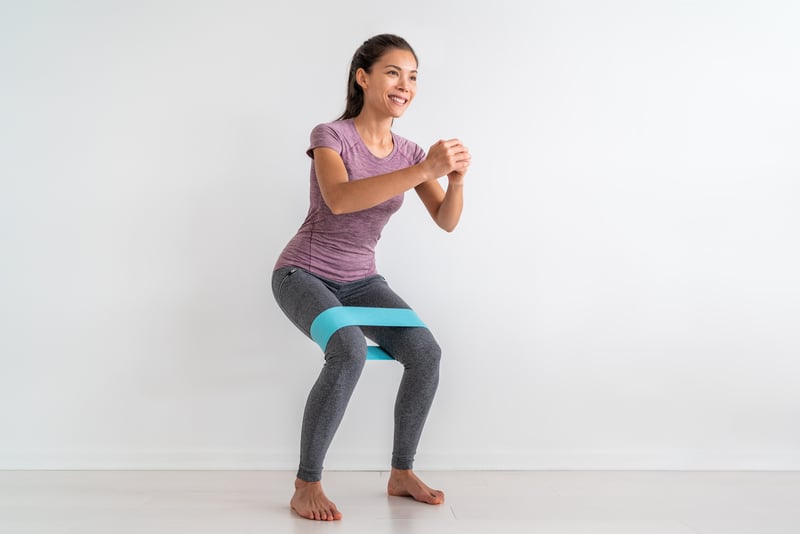Monster Walk: Sculpt Your Lower Body with this Fun Exercise

Have you heard of the monster walk exercise? If you haven’t, you’re missing out! This fun (and effective!) workout is a great way to tone and sculpt your lower body.
What is the Monster Walk Exercise?
You may know this exercise by the name “lateral band walk” (LBW) and you may have seen variations of it being done. Basically, it involves using resistance bands wrapped around your legs at various points and then taking giant, exaggerated wide forward-moving steps.
Benefits of the Monster Walk Exercise
As silly as this exercise might sound (or look), it’s actually extremely beneficial, especially if you have weak glutes or hips or if you experience knee or ankle pain. Since much of this type of pain stems from misalignment, monster walks may be exactly what you need.
This exercise engages all the smaller muscles and tendons in these areas and helps to strengthen and stabilize your stance. You’ll also create a better base for power and protect yourself from injuries due to imbalances and weaknesses in these areas.
While you work your whole lower body, hips, and core, the main mover in the monster walk exercise is the gluteus medius, an often overlooked and underdeveloped set of muscles in your buttocks. These muscles get weakened due to excessive sitting and non-use. They sit laterally underneath the main glute muscles (the gluteus maximus muscles) and work together with the gluteus minimus to rotate your thigh and move your legs out and apart. For example, walking and running rely on these muscles for stability.
What happens when your gluteus medius muscles become weak? You’ll be prone to injury. If you’re experiencing “dead butt” syndrome where your glutes are sleepy due to too much sitting or few to no resistance workouts, they won’t be able to assist with proper movement. This can lead to a cascade of issues from the hips to knees to ankles, and your leg will tend to twist inward, throwing off balance and alignment.
How to Monster Walk
It starts out simply enough. You’ll use a resistance band and start by wrapping it around your legs or ankles. Technically, you can place the band anywhere from ankle to upper thigh, or use multiple bands to increase the difficulty. But, as with everything, start out slowly until you get acclimated to the exercise before increasing reps or resistance. And always avoid placing the band directly around the knees.
After stepping into the resistance band, place your feet hip-width apart and bend your knees to bring yourself into a partial squat position. Keep your head and torso upright and place your hands where they are comfortable (on your hips or perhaps clasped in front of you). Pick up your right leg and bring it up and slightly inward (keeping tension on the band) and then move it forward and set your foot down ahead of you and slightly out past hip width. Repeat with the left leg. Continue this monster walk for ten steps on each side, space permitting.
BREAKING: Forget Taking Collagen, Try This 21-Second Trick for Healthier Skin & Hair Instead
Some Pointers:
- Keep your toes pointing forward. Allowing your toes to point too far outward or too far inward will take the tension off the gluteus medius, and the workout won’t be as effective.
- Don’t allow your knees to cave toward the middle. The point is to push your knees outward toward the bands as you go through the walking movements. Keeping your knees in proper alignment will help to strengthen your kinetic chain and make you less susceptible to injury.
- Don’t rock as you walk. Leaning from side to side as you walk also defeats the purpose of the exercise. No cheating here! Staying level will help you develop the stability, strength, and alignment you need.
- Keep it tight. A loose band is not going to give you the resistance you need to make this exercise effective. Make sure you keep tension on the band throughout your movements for maximum strengthening benefits.
Monster Walk Exercise Variations
No matter how you do the monster walk, you’re going to feel it and get some great benefits. But, if you want to mix it up a little, here are some variations you can try:
Side-to-Side Banded Monster Walk—try setting your leg down to the far-right side instead of forward. Do five steps in this direction and then repeat on the opposite leg going toward your left.
X-Banded Walks—instead of wrapping the band around your knees or ankles, step on the bottom inside loop of the band with both feet, give the band one twist and then grasp the top end loop with both hands. The band will form a figure 8 or an X shape. Next, take giant steps forward, keeping tension on the band with the outside of your foot as you move.
Reverse Monster Walk—this is the same method as the regular monster band walk; simply take steps backward instead of forward.
Overall, the monster walk exercise, in all its variations, is a great way to strengthen weaknesses in your glutes, hips, and knees while at the same time toning your lower body effectively. Add this powerful workout into your routine several times a week for the best results.






